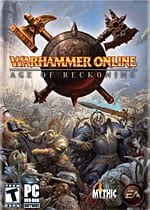Humans, Elves, Dwarves, and Orcs Done Right
Warhammer Online: Age of Reckoning took the MMO community by storm when it was first announced. Since then, fans of the popular Warhammer table-top game and books have flocked. So, what exactly could another fantasy MMO have to offer gamers when there are already so many on the market? Interestingly, the potential for success has been highly debated for a long time running. Sure, Mythic Entertainment isn’t necessarily breaking new ground with its design, but it has certainly taken that standard foundation and built an impressive structure on top.
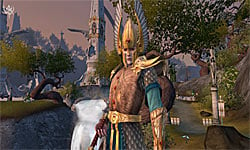
Players are given the option of playing on the side of Order or Destruction. Trying to figure out who the bad and good guys are shouldn’t be a problem. Both sides consist of three races, and each race has its own unique classes. While each class plays slightly differently from all the others, Mythic didn’t hesitate to conform to the standard triad of character archetypes. The tank, healer, and damage per second (DPS) archetypes are all present. One of the first things players will notice when creating a character is that each class is designated as one of the three archetypes, helping eliminate the guess work.
The Empire, the normal humans, Dwarves, and High Elves are joined together to create Order while Greenskins (Orcs and Goblins), Chaos, the evil humans, and Dark Elves make up Destruction. The character creation in Warhammer Online is simplistic. Players choose their side, race, gender, face type, hair type, hair color, facial hair, and eye color. Unfortunately, there doesn’t seem to be many options for each category, so creating a truly distinct character isn’t necessarily a guarantee. On the other hand, most of these attributes end up being covered by the customizable armors and weapons that players can acquire, so the initial character customization isn’t crucial.
Dyeing armor is a feature that reinforces the players’ desire to be unique, and it does it well. There are a number of standard dyes that can be applied by most merchant vendors, and then there are uncommon dyes that are earned through quests or found by looting fallen enemies. Therefore, while many players may have similar armor sets, looking different is just a few dye changes away. Unfortunately, not all armor pieces can be colored. It depends on the armor and, in some cases, the type of item. For example, most capes, if any, can’t be dyed a different color. But, this would make sense considering most capes would probably look the same. Meaning, once a player got their first cape, getting another one and changing the color wouldn’t seem fulfilling since the aesthetics wouldn’t change.
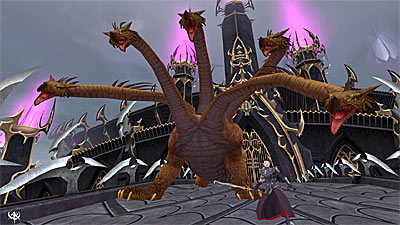
The visuals in Warhammer Online are a mixed bag. On one hand, the style should be applauded as being unique and interesting. City architecture and creature design are top-notch. Conversely, character models seem to lack the detail and finesse that was put into the other areas of the game. Weather effects and the day-night cycle will help keep the environment from becoming stale, but some areas of the world appear to suffer from “no-sun syndrome,” making those areas less pleasing to the players who enjoy the scenery changes. Overall, Warhammer Online falls short without next-generation graphics, but when attempting to create large-scale combat between countless players, Mythic had to make some sacrifices. This isn’t to say that the graphics are terrible or hard to stomach because they aren’t dated for an MMO, but they aren’t going to turn heads either.
The Warhammer Online game world is split into three main maps. Each map contains a pairing of races, Empire vs. Chaos, Dwarves vs. Greenskins, and High Elves vs. Dark Elves. Then each of those divisions is split into four “tiers,” and each tier acts as a certain stage for the progressions of the players’ characters. As players earn ranks and gain experience, they are eventually moved on to the next tier of maps. At first glance, the game world design feels very linear for an MMO. Most of the pairing maps show paths that lead in two or three directions, but the progression is always to the next tier. However, most MMOs tend to do the same thing, the only difference here is that Mythic is pointing it out and making it understandable. On top of that, players from each race have the ability to visit the other races’ areas shortly after beginning, so players shouldn’t feel too limited.
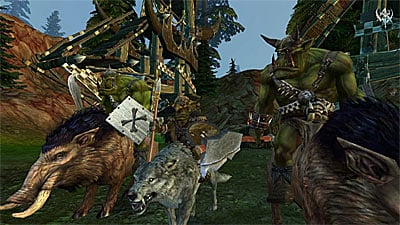
Another interesting design element to the tiered structure of the game world is how races from both realms will share each of the maps in the progression. One side of a large formation of mountains could be the Empire’s starting area, while the other side could be Chaos’ starting area. Each map splits the PvE and RvR areas so that both sides can have access to both without the two interfering. Additionally, players who would prefer to fight against players from the enemy realm can choose to play on what’s called Open RvR servers.
One thing that really stands out in Mythic’s PvE design is the inclusion of public quests, which are basically short-story quests that players can join and end by entering and leaving a certain area. When a player gets close enough to a public quest area, a short message will pop up. Public quests are completed in stages, and each stage adds tougher enemies until the last stage. Players earn both experience points toward their overall rank and influence points, which are gained by only doing public quests. As public quests are completed, players will earn enough influence points to receive standard items ranging from potions to weapons and armor. Moreover, during each session of a public quest, players will have the chance to earn loot based partially on luck and contribution.
Contribution to the public quest isn’t just calculated by damage done either, but by healing and group support through spells and abilities. All these elements make public quests both fun and easy to take part in. However, the term public quest does tend to infer that players will need each other to complete them, so problems could occur when the lower-tiered public quests have no players around to do them. Ultimately, as time passes, this design flaw will impact the guild-less player, causing them to miss out on potentially better items and, on a more lofty level, game content. Currently, there isn’t a problem because there is no shortage of lower-ranked players, but tweaks will most definitely need to be made later on.
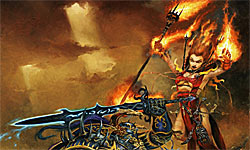
Warhammer Online’s PvP elements are a definite ray of Elven sunshine. Mythic has divided its PvP priorities into two forms: Scenarios and Open-world RvR. Scenarios are played like instanced team vs. team matches between Order and Destruction. Players can join scenarios as easily as clicking a button on the HUD. Groups of players that have banded together also have the option of joining and playing scenarios together.
Once inside the scenarios, players can expect standard modes of gameplay. Capture the flag and capturing and defending control points are just a few of the game modes. There are some additional ones that add a twist here and there, but it isn’t anything veteran gamers haven’t seen or played before. When players select to join a scenario, they are placed in a queue, so while the game is preparing a scenario, players can continue to go about their business. Once the scenario is ready, players can join and are instantly loaded into it. Once the scenario is finished, the game places the players back where they were within the game world, allowing them to pick up where they left off. For once, these out-of-world zones aren’t tedious or pointless to play, and those who would normally find them to be a waste will catch themselves actually having fun.
Open-world RvR plays out in predetermined areas of each map and there are no multiple instances of the same thing. Battlefield objectives are scattered throughout these contested areas. Each tier has two maps in it, each with its own set of objectives. When one realm captures and holds all those objectives, bonuses are given to the players of that realm and the game acknowledges their dominance. Eventually, Mythic’s idea leads to one realm being able to capture and hold all the objectives of each tier until the end, which results in the siege of the other realm’s capital city.
Players will earn points for two different ranks, one is their overall rank and the other is their Renown Rank. Earning renown is a matter of participating in PvP, whether it’s scenarios or open-world RvR. As players earn renown points and ranks, they get access to renown abilities, which can be used to help their characters become more powerful. Of course, the issue of low-level player populations cannot be ignored. How will the balance be impacted when there aren’t any players left in the early tiers of the game?
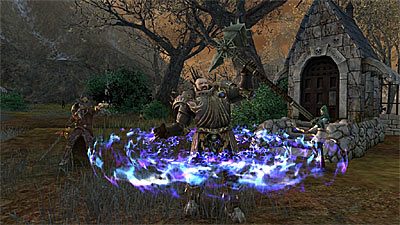
Warhammer Online makes it so everything matters and contributes to character or guild progression. Players unlock abilities and special awards for killing certain numbers of specific types of enemies, for exploring uncharted corners of the maps, and for doing things that are normally mundane. The brilliance of this system is that MMOs tend to be reward-heavy games anyway, so why not make everything the players do a form of progression. For instance, killing 100 wolves could result in an unlock that gives a special cape or armor piece.
There are a lot of features that make up Warhammer Online. Most of those features aren’t anything veterans of the genre don’t already know and understand. And, there are a complement of bugs and glitches that accompany this giant, but the core gameplay is solid. Warhammer Online isn’t trying to reach a specific audience either, regardless of Mythic’s original intention. Instead, it seems to be creating a whole new audience, turning and redefining players’ expectations and behaviors. If MMOs are what you enjoy, Warhammer Online is one of the best on the market. It may not have a new combat system built from the ground up, or flashy next-generation graphics, but its success without those two elements is a feat in its own right.
RATING OUT OF 5 RATING DESCRIPTION 3.5 Graphics
A stylistic design only set back by its less than next-gen display. 4.5 Control
Simple and easy-to-master controls with the standard, yet necessary, customization features. 3.5 Music / Sound FX / Voice Acting
Original musical scores thump, the sound effects are a hit or miss thing, and the ham-fisted voice acting is generally forgivable. 4.8 Play Value
A solid gaming experience that is only marked by occassional gltiches and potentially problematic game progression. 4.7 Overall Rating – Must Buy
Not an average. See Rating legend above for a final score breakdown.
Game Features:
